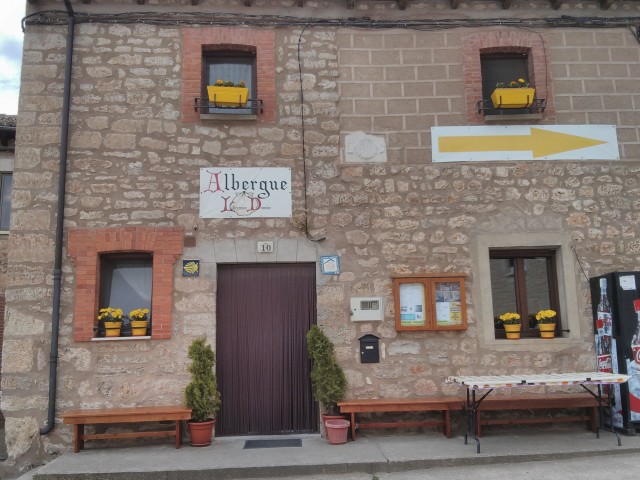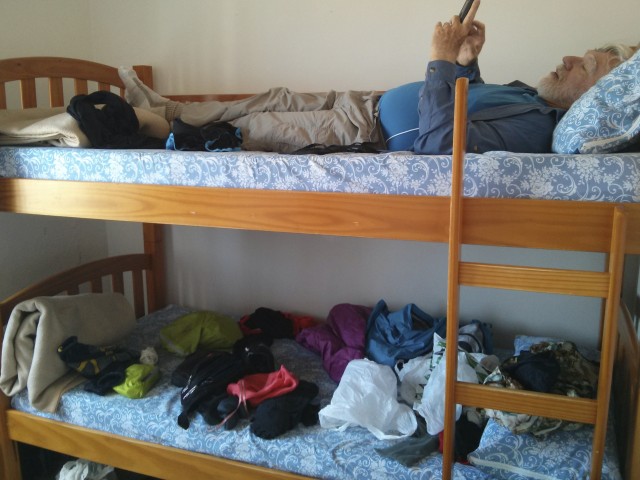Charlie: One of the great things about the Camino is all the services set up for pilgrims. One of these is the albergues. These are the places with lots of bunk beds in large rooms. You get a mattress, the lower bunks go first, and usually a pillow and a blanket if you need one. Like summer camp except a lot more snoring, which increases with age it seems.
We planned from the beginning to stay mostly in hotels and pensions and only in a few albergues. That is what we have done. We have stayed in albergues two times out of 35 nights.
That decision is problematical though. The albergues are part of the culture of the Camino. They are where you meet lots of other pilgrims. Also everyone gets up and gets going early, you have to be out by 8, so it gets you more into the rhythm of the Camino.
You also gain a lot of flexibility since they have albergues in every little place, places where there is no hotel.
The cost is a lack of personal space and a place to relax. They can also be pretty cold. They don’t seem to have heat.
I can see the tradeoffs and I am glad we are doing it the way we are. Everyone walks their own Camino and meeting a lot of other pilgrims was not my reason for walking. I have talked elsewhere about things I was looking for. We still talk to a lot of people but we don’t have the (not so) late night bull sessions with people like you do, say, in a college dorm. But for me, been there, done that. And I am mostly an introvert and like my alone time. Other people would make other decisions.
Another consideration is cost. The albergues are really cheap, €5-10 each. We have been averaging about €40 a night in hotels (20 each). Also most albergues have kitchen facilities so you can go to the store with some other pilgrims and cook up a communal meal pretty cheaply. You could easily walk the Camino for €25 a day and €15 a day of you were really careful. (Food from the grocery store is very inexpensive.)
Overall I would say anyone young or extroverted should definitely stay in albergues. Other people should weigh the factors and decide what is best for them. If you enjoy camping you should also stay in albergues because it is a lot the same but easier since you get a mattress and a roof. I would say that you should also stay in albergues if you enjoy flying coach on long international overnight flights but that might reveal my prejudices so I won’t say that.
One thing we have noticed is that almost everyone we meet is staying in albergues. This includes the people we meet in the hotels and people our age. Usually they just stay in hotels once in a while, like once a week. And others are staying there because the albergues are full or they arrived too late.


Pardon my long reply to Charlie’s “Albergue or Not” and Wynette’s “Hard Day and the Cruz de Ferro” postings. Wikipedia claims that the number of pilgrims in recent years exceeds 150,000 (with even more in Holy Years, when the Feast of St. James falls on a Sunday), but that 30 years ago, when Elyn Aviva walked the Camino, essentially nobody did this. As Wynette noted, she had trouble finding basic services along the route — not a problem today, as providing services to those walking the Camino has become a big business (or, more accurately, a large collection of small businesses).
In Ms. Aviva’s day, and during the Middle Ages, the pilgrimage was a religious, or, at least, a spiritual experience. Today, while there are some people for whom this is true, and others for whom this is one component of the journey (Charlie and Wynette seem to fall into this category), I imagine that for many of the “pilgrims,” especially the younger, college age ones, it has become more of a summertime frolic. In my experience this tourist-adventure, as opposed to spiritual journey, has also taken over trekking as well: popular routes, like Everest Base Camp or the hike up Kilimanjaro, are overrun with trekkers, most of whom are not there for the solitude and spirituality, but for the “adventure” (I managed the high altitude) or “I did it” (cross that one off the bucket list). This isn’t to condemn or criticize; it is just what has happened as the word of these experiences has gotten out.
And talking about the Middle Ages…The Michelin Green Guide for Spain claims that there were between 500,000 and two million pilgrims a year. That is a huge number, not only in absolute terms, but if you think about the population of Europe at the time, this is truly astounding. There was a complete infrastructure: the Knights Templar provided security from brigands and the Knights Hospitallers set up hospitals, such as they were, and hospices. The Catholic Church was a big fan of the pilgrimage, partly because it increased the Christian presence in Spain, which was still about 50% under Muslim control.
Charlie and Wynette have many conveniences that the Middle Age pilgrims lacked, like mobile phones and wi-fi,… and let’s not forget the most important of all: cafe con leche.
Henry Shapiro
Henry, really enjoyed reading your comment. It truly is astounding how many did this pilgrimage in the Middle Ages. I’ve thought of those pilgrims many many times as we’ve gone along. Most of them traveled much further (had to go to Santiago from their home from somewhere deep in Europe and then go back!) and of course it was much harder and more dangerous. (We’ve felt completely safe.) Those pilgrims were highly motivated.
Oops, above comment by Wynette.